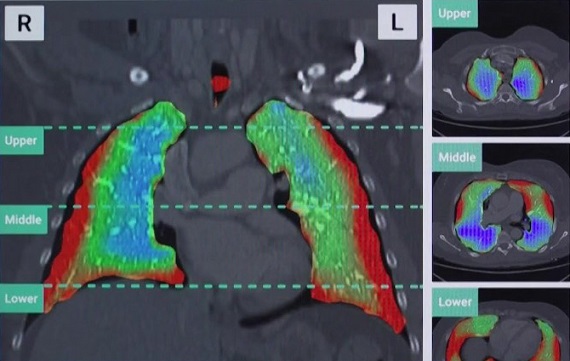Medical Innovations: Novel Imaging Software Can Give Better Lung Diagnosis For Individuals Who Are Intolerant To Contrast Dyes
Nikhil Prasad Fact checked by:Thailand Medical News Team May 18, 2024 1 year, 7 months, 2 days, 23 hours, 23 minutes ago
Medical Innovations: The advent of new medical technologies has always been a beacon of hope for patients and healthcare providers alike. Among the latest
Medical Innovations is a groundbreaking imaging software that promises to revolutionize lung diagnosis, especially for those who cannot tolerate contrast dyes. This development is particularly significant for the estimated 30% of patients who are allergic to medical contrast dyes or have other health conditions that restrict their use. These patients often face prolonged diagnostic processes when dealing with critical lung issues like pulmonary embolism, as alternative imaging methods without contrast dyes tend to be less accurate and more time-consuming. However, the new software, developed by pulmonologist Dr Girish Nair, M.D., and biomedical engineer Edward Castillo, Ph.D., is set to change this scenario.
 Novel Imaging Software Can Give Better Lung Diagnosis For Individuals
Novel Imaging Software Can Give Better Lung Diagnosis For Individuals
Who Are Intolerant To Contrast Dyes
Introducing CT-Derived Functional Imaging (CTFI)
CT-Derived Functional Imaging (CTFI) is a sophisticated computed-tomography software program that leverages advanced mathematical formulations to analyze lung volume changes as a patient breathes in and out. Specifically, it employs the Integrated Jacobian Formulation to quickly and accurately calculate major changes in lung volume and blood mass. This method provides consistent data for each patient, enabling more precise diagnoses and targeted therapies without the need for contrast dyes.
Dr Nair who is a pulmonologist with Corewell Health in Michigan, highlights the significance of this innovation: "Up until now, a major problem with lung volume estimations from inhalation and exhalation CT scans was that results couldn't be replicated for individual patients. This inconsistency made diagnosis and treatment more challenging."
Benefits for Cancer, COPD and Lung Fibrosis Patients
The applications of CTFI extend beyond those who cannot use contrast dyes. It offers substantial benefits for patients with chronic obstructive pulmonary disease (COPD) and lung cancer. In radiation oncology, where precision is critical, the software ensures that radiation targets only the tumor while minimizing exposure to healthy lung tissue. This precision reduces the risk of collateral damage and enhances treatment efficacy.
Dr Nair explains, "Directed radiation to treat a tumor is essential. If the patient is breathing in and out, the tumor will naturally move or change position, potentially causing radiation to affect other areas of the lung. Our software can help limit this by providing accurate data on lung and tumor movement."
Addressing Pulmonary Embolism
One of the most remarkable uses of CTFI is in the diagnosis of pulmonary embolism. Traditionally, when contrast dyes cannot be used, patients are either observed with anticoagulant drugs, which carry a bleeding risk, or sub
jected to nuclear scans that involve radioactive substances. CTFI offers a simpler, non-invasive alternative by measuring blood mass changes through inhalation and exhalation CT scans.
"This method is easier and doesn't involve the risks associated with drugs or radioactive substances," Dr Nair notes.
Predicting COPD Progression
Recent studies presented at ATS (American Thoracic Society) 2024, an international health symposium, revealed that CTFI can predict disease progression in COPD patients over a decade - a capability that current technologies lack. In a retrospective analysis involving 8,583 COPD patients, researchers demonstrated that CTFI could improve predictive models for patient mortality risk, monitor disease progression under treatment, and identify patients at higher risk of rapid disease advancement.
Edward Castillo emphasizes the potential of integrating AI with CTFI: "AI has the potential to further our work significantly in order to improve patient health and save lives. Our goal is to ensure doctors have the best tools available for treating patients."
Understanding Contrast Dye Allergies
While CTFI offers a significant advantage for those who cannot use contrast dyes, it's essential to understand the issues associated with contrast dye allergies. Contrast dyes, typically iodine-based or gadolinium-based, are used in imaging tests like MRI and CT scans to enhance the visibility of internal structures. Although severe allergic reactions to these dyes are rare, they can be serious.
Most reactions occur within an hour of administration, with symptoms ranging from mild (warmth, nausea) to severe (difficulty breathing, hives, rapid heart rate). Factors that increase the risk of a reaction include a history of similar reactions, asthma, heart or kidney disease, and the use of beta-blockers.
Treatment for contrast dye reactions is symptomatic, often involving injectable epinephrine, antihistamines, and IV fluids for severe cases. Preventive measures include pre-medication with corticosteroids and antihistamines for those with a history of mild reactions.
In cases of severe past reactions, healthcare providers may opt for alternative imaging methods or different classes of contrast agents with lower risk profiles. Patients are advised to discuss any concerns or previous reactions with their healthcare providers to evaluate the risks and benefits of using contrast dyes in diagnostic tests.
Conclusion
The development of CT-Derived Functional Imaging represents a significant leap forward in medical imaging technology. By providing accurate, reliable lung diagnostics without the need for contrast dyes, CTFI addresses a critical gap for patients who cannot tolerate these substances. Its benefits extend to more precise cancer treatments and better management of chronic lung diseases like COPD. As this technology continues to evolve, it holds the promise of significantly improving patient outcomes and enhancing the capabilities of healthcare providers in diagnosing and treating lung-related conditions.
Reference:
https://corewellhealth.org/2024-05-new-imaging-software-improves-lung-diagnosis-for-30-of-patients-who-cant-tolerate-contrast-dye-has-added-diagnostic-benefits-for-all-patients
For the latest
Medical Innovations, keep on logging to Thailand Medical News.
